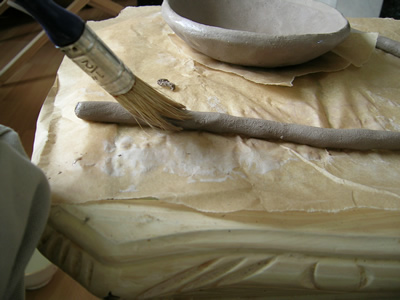|
|
Home →
Survival →
Containers →
Pottery
Three Methods of Making Pottery
by
Anthonio Akkermans
(Page 1 of 2)
|
|
Though I will only be making one pot during this tutorial, I will be
explaining three methods. The pot I am making is going to be in the style of
"Borger Cordmarked" earthenware. It involves using a paddle wrapped with
cord (natural, hand-made of course). This leaves distinctive marks.
Pottery was made using this method because it produced lighter, yet
stronger pottery. Because of the cordage marks, it was also easy to
handle, even when slippery from cooking-grease etc. |
 |
I am going to start by making a base
for my pot (the pot will ultimately be about a foot and a half
high). I am going to make this base using a method often referred to
as "pinching a pot" (method one).
First I get a golf-ball size bal of clay, which I knead and knead,
until I am certain there are no air bubbles left in the ball of
clay. Then I shape it into a nice round ball. |
|
|
|
 |
I start the shaping of the pot, by
careful pressing my thumb into one side of the ball. As soon as I
make a minor indent, I remove my thumb, spin the ball slightly, and
press again in exactly the same spot. |
|
 |
While I am doing this, I make sure to apply more
pressure downward then towards the sides for now. it is also very
important to keep the clay moist, especially the rim. If you don't,
the clay will crack, rendering it useless. |
|
 |
I keep going around and around,
pressing my thumb in the ball, until I am about a quarter of an inch
away from the bottom of the pot. Then I start pressing towards the
sides. |
|
 |
I want the whole pot to have an even
thickness, otherwise I may have problems when firing the pot (such
as cracks
or explosions). This means that in my case, the sides of my pot are
going to be a quarter of an inch, just like the bottom. |
|
 |
When I am nearly there, I place the
pot on some sort of surface. I covered the surface with baking paper
to stop the pot from sticking to the table I am working on. Once
it's on the table, I can concentrate on perfecting the sides, as
well as making sure the walls are of equal height. |
|
 |
Now I let the pot dry in front of the
warm fire place (it's a cold morning here in County Down (Ireland)!) for a while,
so that the next layers will not be too heavy a burden to carry for
the bottom. At this stage, I could stop and let the pot dry
completely and fire it. It will make a nice wee bowl. This is then
the first method of making a pot completed. |
|
 |
Now, I will continue my pot using a
different method that allows me to make bigger pots without a
potters wheel. I will start to "coil-build" the pot.
It is important to ensure that the rim of the pot is wet in order to
receive the coil that goes on top of it. |
|
 |
I also make sure that the coil is wet
and sticky. I am using a brush, because it helps to create tiny
scrapes in the coil, which will make it easier to adhere to the
moist rim. |
|
 |
The next step is to lay the coil on
top of the rim and lightly press it into place. Because I am going
outward with the walls of the pot, I am placing the coil exactly on
top of the rim. |
|
 |
Once I reach the beginning of my coil,
I just continue on top of it. |
|
 |
I keep on going with this coil until I
have been around the entire rim twice. Then I stop. I don't want to
make the new clay too heavy for the bottom to bear without drying it
further. |
|
 |
Now I use my fingers to smooth out the
coils, and make the walls of the basket nice and even once again. |
|
 |
At this point, my description of the
second method is finished. I could just keep going with this method
until my bowl reaches the size I am happy with. Then dry and fire
the pot. However, it will be quite a heavy pot if I want to have a
decent sized pot, and therefore not very mobile. I want to show you
a method next, which makes the walls a lot thinner as well as
stronger.
Now I need a paddle, with some natural cordage wrapped around it.
The fibres of the Nettle work rather well. I also need a nice round
stone, which will be used as an anvil.
Putting the anvil inside the pot, I hit the pot lightly from the
outside with the paddle. Not only will it make the walls thinner and
stronger, it will also smash those coils even tighter together and
get rid of any air bubbles that may inadvertently have been trapped
inside the clay. |
|
|
|
|
Page 1
Page 2 |
|
|
|
|